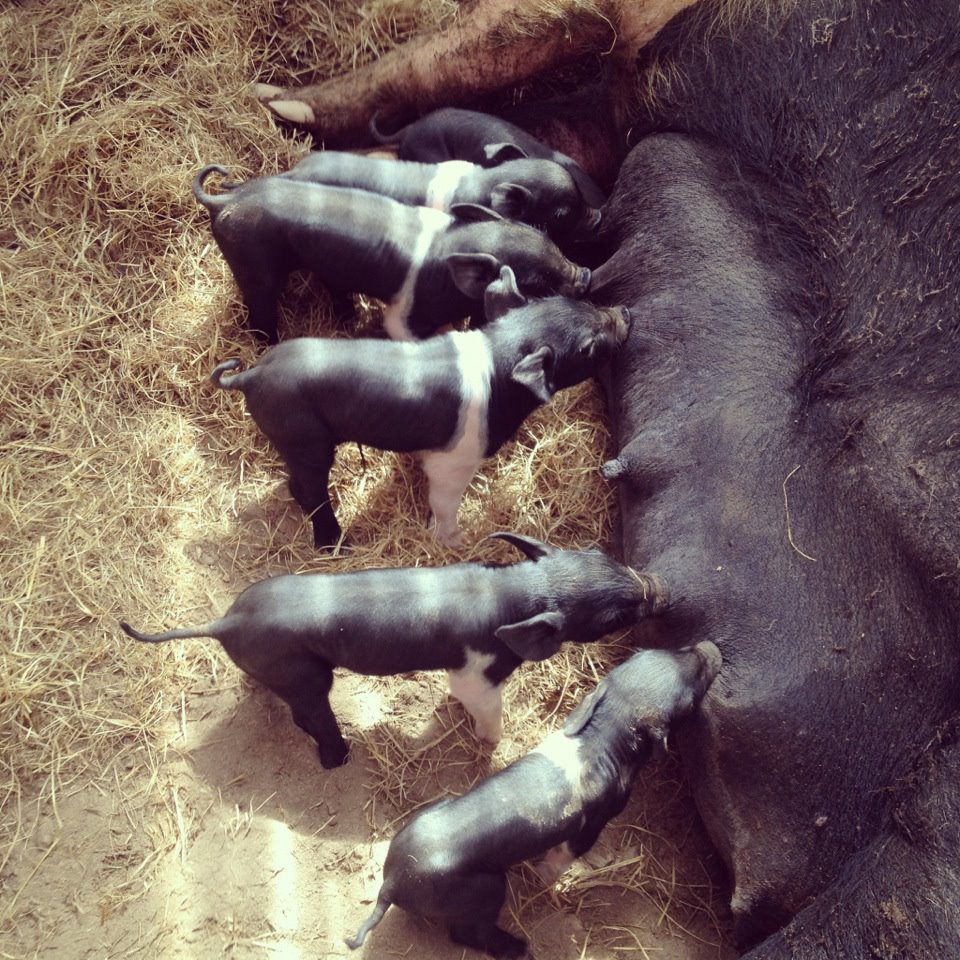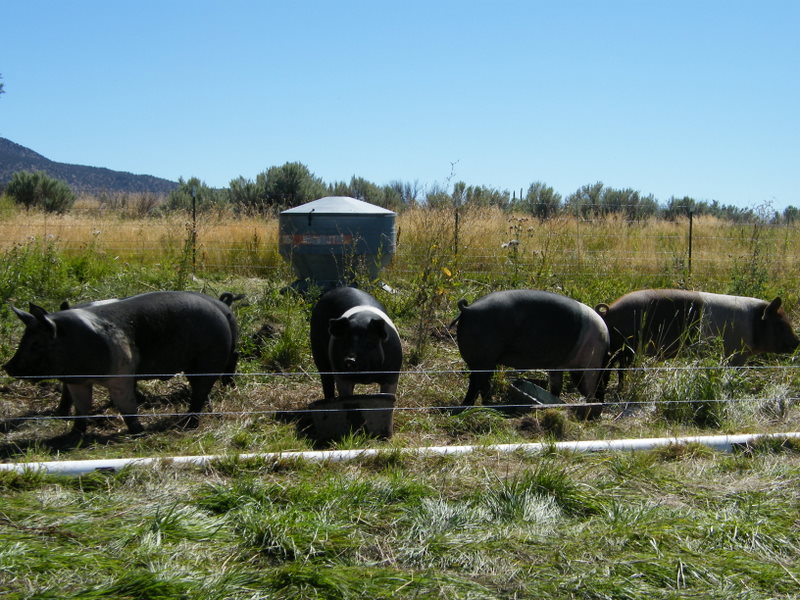If the post title has you scratching your head- hold on for a wild ride of confusing terms and fuzzy math!
TL;DR The butcher shop is now leaving the skin, head, and feet on the hog- which increases the hanging weight. We are lowering prices to account for this. Also, when butchering you will have more options- but, depending on your cutlist- might cost more. Whole hog share price drops from $3.25 to $2.85 and a half will drop from $3.75 to $3.30.
First let’s create a typical hog- Hank. Hank was raised on the farm- always on pasture, fed our custom rations, and lived a good life. But it is time for Hank move on to the next step in the circle. Hank can be measured in several ways:
- Live weight (let’s start at 250 lbs)
- This is how much Hank weights during his final days. This number is important to farmers- but not really to consumers. Farmers need this number to calculate feed conversion rates, average daily gain, classifying breeding stocks and general sorting. While at the slaughterhouse Hank is inspected by an independent USDA inspector- to ensure that the live animal is fit for conversion into human food.
- Hanging weight (Hank was 200/lbsin 2020, but now is 230/lbs(explanation below)
- This is where money starts getting into the mix. Hanging weight is pretty literal….Hank is slaughtered, the blood has been drained, the offal removed and carcass is opened up to chill- all while hanging from a rail. Here the USDA inspector looks at the internal organs for disease and the quality of the carcass. This is where the change is taking place:
- In the past- the slaughterhouse would remove the trotters, head, skin, along with the organs. So, Hank would have weighted maybe 200 pounds. The consumer would have paid us $3.25/lbtimes 200 lbs= $650. If you were to butcher the hog yourself- that would be your total cost for Hank (remember we always cover the slaughter).
- But now- the slaughterhouse purchased a scalder/shaver over the winter. This is both good and bad for both of us. The good is we get lots more options. We can now make pickled pig’s feet, hang our hams with the skin on (yes!), make cracklinswith fresh bellies, make head cheese, etc. The other major advantage is for you pit masters out there- Central Oregon can know offer skin-on barbeque hogs. This is all great and we (and many customers too) have wanted these options for a long time. The downside is that by leaving the head, skin and trotters on the hog- the hanging weight is going to be higher. Now, Hank will likely weight closer to 230 pounds. That means the consumer would pay $3.25/lbfor 230 lbs~ $750.
- This doesn’t make a lot of sense to us- nothing changed to way we raised Hank or the associated costs- yet we’re charging an extra hundred dollars? To balance things out we’ll now change $2.85/lbshanging weightso- $2.85/lbfor 230 lbsgoes back down to $655.
- This is where money starts getting into the mix. Hanging weight is pretty literal….Hank is slaughtered, the blood has been drained, the offal removed and carcass is opened up to chill- all while hanging from a rail. Here the USDA inspector looks at the internal organs for disease and the quality of the carcass. This is where the change is taking place:
- Retail weight (230lbs down to ?)
- Hank is now down to 230/lbs, chilled and ready for butchering. No matter how you want this hog cut and wrapped- you will be charged $.75/lb. So, for Hank, the butchering fee will be $.75 * 230 = $172 (on top of the $655 you paid us). We have no control over this number. Again- we have a good and bad situation. The good is the folks that want every bit of that hog are thrilled. However, I think the reality is most folks aren’t going to want these new offerings- but the will have to pay $23 more and not receive anything for their money. This includes us- we’ll try and sell trotters- but will not even attempt heads. Let’s breakdown retail weight further- into an adventurous group and a conventional group:
- The adventurous group- they want it all. So, the retail weight and the hanging weight will essentially be the same. The price per pound will be $655 to the farm and slaughter, and $172 to the butcher = $827. Now divide $827 by 230 means you get a freezer full of Hank for just $3.60/lb!
- For the conventional group- let’s say they want mostly boneless cuts, want the fat trimmed tight, don’t even want to see the head- let alone bring it home, have no need for trotters, and think pork rinds are gross. This all adds up to the retail weight being much less but the cost are the same. Let say the retail weight (the pounds that you actually put in the freezer)- drops down to 165 lbs. Now the net cost per pound is $655 for the farmer and slaughter, $172 for butchering = $827 divided by the retail weight of 165 = $5/lb….28% more – but you’ll have exactly what you want and not a freezer full of kidneys and feet!
- Hank is now down to 230/lbs, chilled and ready for butchering. No matter how you want this hog cut and wrapped- you will be charged $.75/lb. So, for Hank, the butchering fee will be $.75 * 230 = $172 (on top of the $655 you paid us). We have no control over this number. Again- we have a good and bad situation. The good is the folks that want every bit of that hog are thrilled. However, I think the reality is most folks aren’t going to want these new offerings- but the will have to pay $23 more and not receive anything for their money. This includes us- we’ll try and sell trotters- but will not even attempt heads. Let’s breakdown retail weight further- into an adventurous group and a conventional group:
- Cures
- This is unchanged- take any retail cut from above and have it cured for another $.75/lb. Options for you are bacon (jowl, belly, coppa, loin)…and hams- both whole and sliced into steaks. The ham making process is not USDA- that is why we don’t sell hams- but you can order them. Oh….and don’t forget smoked hocks!
- Who keeps track of all this? We do! When you purchase a hog from Great American everything will be itemized out and we pay all the fees associated with your hog and include it on the invoice. You only need to write one check!
Make sense? Exhausted?
If you are interested in a hog- let us know! If you have questions- please comment below and we’ll answer for you and the next guy cruising our site.
Two more notes:
- These fees are retroactive- if you have already ordered a hog for 2021- the new prices apply. If you have an issue with a ‘lower price, possible higher costs, and more options’- just let us know and we will work things out with you.
- The math was easy to do with a whole hog….everything is the same with a half share- just cut the weights in half and reduce the half share price 13% from $3.75 to $3.30.


One response
Thanks for looking out for us + still giving us a good deal. I am definitely one of the more adventurous but the new offerings do not appeal to me. Though I eat my share of offal, I will stop at eating what you euphemistically referred to as “head cheese” . And the feet thing, I don’t get what there is to eat there, its the same thing with chicken feet. I heard the cheeks were good, or was that just Halibut? There is a way to eat much of this and be more resourceful, and this even includes the guts.
I have slaughtered + butchered much of my own meat, all of it last year, and I did not waste much. This is what I did. I fed the cats the “head cheese”. Then the chickens got the head cheese leftovers and the guts. Chickens eat anything. Then I ate the Chicken eggs. So I didn’t eat it directly, but I ate it transformed into eggs. I was not working with anything as big as a pig and I don’t think you will want to bring back hundreds of pounds of guts back from the butcher to feed your chickens, but it is a good way to go for all of those who slaughter on site. It is actually high quality feed and costs… nothing.